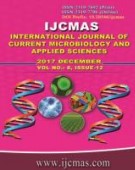


 National Academy of Agricultural Sciences (NAAS)
National Academy of Agricultural Sciences (NAAS)

|
PRINT ISSN : 2319-7692
Online ISSN : 2319-7706 Issues : 12 per year Publisher : Excellent Publishers Email : editorijcmas@gmail.com / submit@ijcmas.com Editor-in-chief: Dr.M.Prakash Index Copernicus ICV 2018: 95.39 NAAS RATING 2020: 5.38 |
In the present investigation, the Trichoderma atroviride spp. were isolated from the soil samples and potent antagonists of these isolates were selected for screening against the fungal phytopathogens Aspergillus flavus and Fusarium solani causing various diseases of crops. The soil samples were collected from various local rhizosphere of Bihar state and were inoculated on the Trichoderma Specific Media (TSM) and Potato Dextrose Agar (PDA) media using the serial dilution technique. After a series of inoculations, 18 different Trichoderma isolates were obtained in which the isolates of Trichoderma atroviride Ta2, Ta5 and Ta7 having a higher radial growth at optimum temperature were selected, for screening its antagonistic potential. These isolates of T. atroviride were identified using authentic manual of fungi for morphological, microscopic and further identification was done based on molecular techniques using D1/D2 region of LSU (Large SubUnit:28S rDNA). These selected antagonists were checked for screening its antagonistic potential against the two fungal phytopathogens namely Aspergillus flavus and Fusarium solani. Both the pathogens were isolated from rotten papaya (Carica papaya) collected from local markets of Samastipur district of Bihar in India and were confirmed by microscopic identification. The screening was done using three antagonistic techniques namely Dual culture, Culture Filtrate Assay and Slide culture Assay. In the dual culture technique, the isolate Ta5 showed maximum 85.4% and 73.1% growth inhibition against A. flavus and F. solani respectively. The cell free culture filtrate which was extracted from Ta2, Ta5 and Ta7 isolates were screened at three different concentrations i.e., 20%, 40% and 60%. The screening of culture filtrate against these fungal phytopathogens shows significant inhibition of radial growth especially at 40% and 60% concentration. Similarly, the Ta2, Ta5 and Ta7 isolated were grown with both fungal pathogens on slide culture and the growth of mycelia was measured. The impact of slide culture method was marked as reduced mycelial growth of both fungal pathogens. These three techniques used for antagonistic effect of Trichoderma atroviride isolates against the selected fungal pathogens confirmed the antagonistic potential of the local Trichoderma atroviride isolates.
 |
 |
 |
 |
 |